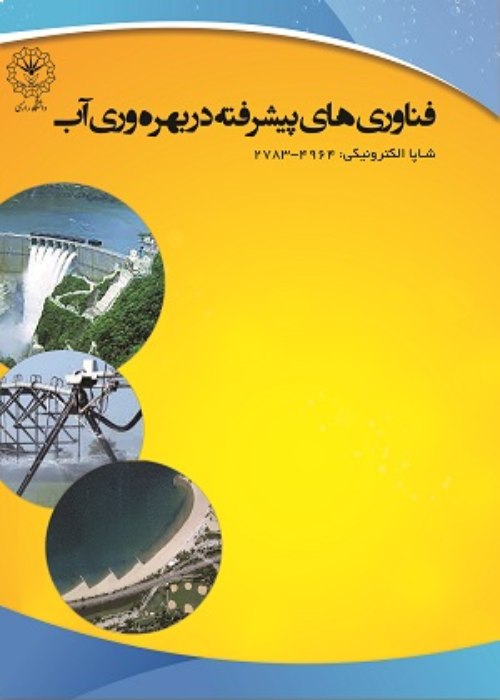Evaluation of Various Irrigation Management for the Automation of the Sprinkler Irrigation System
Author(s):
Article Type:
Research/Original Article (دارای رتبه معتبر)
Abstract:
In Iran, pressurized irrigation systems cover a large area of agricultural land, but water use efficiency remains low because farmers tend to do deficit (over) - irrigation due to their lack of knowledge of crop water requirements. To address this issue, irrigation systems can be automated, and it is important to estimate crop water requirements accurately. This can be done based on soil moisture deficit or meteorological data. The water required can then be applied using a volume meter or by determining irrigation time based on the sprinkler flow rate. The study aimed to compare crop water requirement estimates based on soil moisture deficit and meteorological data, as well as the amount of water applied using volume and time-based methods.The study was conducted in the research farm of Razi University, Kermanshah, Iran, on a sprinkler irrigation system equipped with pressure and flow measuring devices, pressure switches, and electrical valves. The field was under corn cultivation, and four types of irrigation management were evaluated, which included a combination of two methods of determining crop water requirement (soil moisture deficiency and meteorological data) and two methods of irrigation application (time or volume). The four treatments were soil moisture - time (MT), soil moisture - volume (MV), weather - time (WT), and weather - volume (WV). The crop water requirement was calculated using the Penman-Monteith formula based on daily weather data. Soil moisture was measured at different depths one day before irrigation, and the soil moisture deficit was calculated to determine the crop water requirement based on soil moisture. The irrigation volume for each sprinkler in the irrigation cycle was calculated using equations that written in the paper.In the volumetric-based method (treatments WV and MV), the volume of water applied was measured using a water meter with a precision of 0.1 liters, and irrigation was stopped after passing the required volume of water. In the time-based method (treatments WT and MT), the irrigation time was calculated by dividing the irrigation volume by the average flow rate of the sprinklers (3 liters per second), and irrigation was stopped after the calculated duration. The actual sprinkler flow rate was calculated based on the volume of applied water and irrigation time in each treatment and irrigation round. Crop yield was measured at the time of harvest in the studied treatments and a control treatment managed by the Faculty of Agriculture. The irrigation treatments were not applied in the first month of the growth period due to field limitations.The results show that the crop water requirement calculated based on meteorological data at the beginning and end of the growing period was more than the method based on soil moisture. In total, the amount of crop water requirement calculated based on soil moisture was 8% more than the meteorological-based method. The volume of applied water in treatments of MT and WT was 14 and 8% more than in MV and WV treatments, respectively.The actual flow rate of sprinklers was different from the design flow rate due to irrigation situations in other parts of the farm. The average discharge of sprinklers (12 irrigation events) in WT, MT, WV, and MV treatments was 2.79, 3.03, 3.27, and 3.12 l/s, respectively. The irrigation time in volume and time-based methods also showed a significant difference. The irrigation time in MT and MV treatments was 10 and 18% longer than in WT and WV treatments, respectively. The study found that due to the non-uniformity of sprinkler discharge, applying irrigation by volume method is better than the time-based method. The results suggest that the MV treatment, which determined the amount of irrigation based on soil moisture deficit and applied it using a volumetric method, is a suitable option for automating sprinkler irrigation systems in the studied region.
Keywords:
Language:
Persian
Published:
Journal of Advanced Technologies in Water Efficiency, Volume:3 Issue: 3, 2023
Pages:
1 to 19
magiran.com/p2661508
دانلود و مطالعه متن این مقاله با یکی از روشهای زیر امکان پذیر است:
اشتراک شخصی
با عضویت و پرداخت آنلاین حق اشتراک یکساله به مبلغ 1,390,000ريال میتوانید 70 عنوان مطلب دانلود کنید!
اشتراک سازمانی
به کتابخانه دانشگاه یا محل کار خود پیشنهاد کنید تا اشتراک سازمانی این پایگاه را برای دسترسی نامحدود همه کاربران به متن مطالب تهیه نمایند!
توجه!
- حق عضویت دریافتی صرف حمایت از نشریات عضو و نگهداری، تکمیل و توسعه مگیران میشود.
- پرداخت حق اشتراک و دانلود مقالات اجازه بازنشر آن در سایر رسانههای چاپی و دیجیتال را به کاربر نمیدهد.
In order to view content subscription is required
Personal subscription
Subscribe magiran.com for 70 € euros via PayPal and download 70 articles during a year.
Organization subscription
Please contact us to subscribe your university or library for unlimited access!



